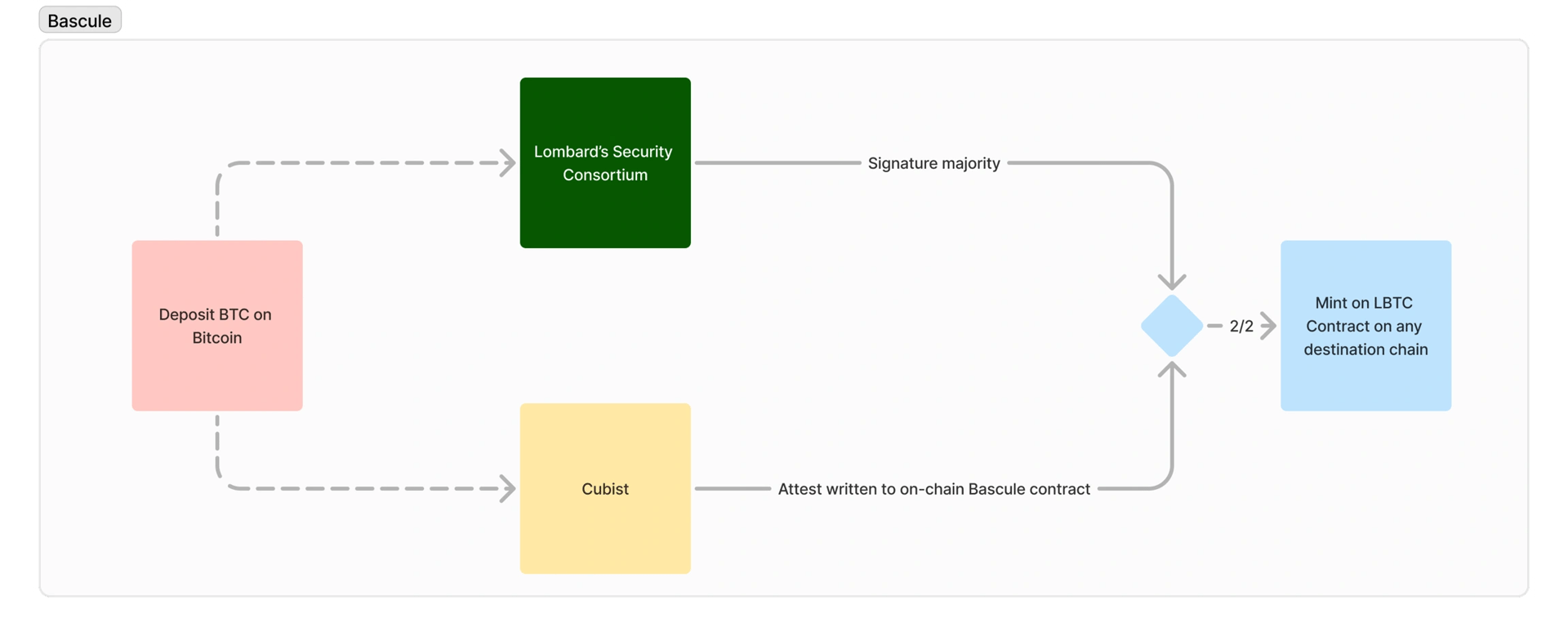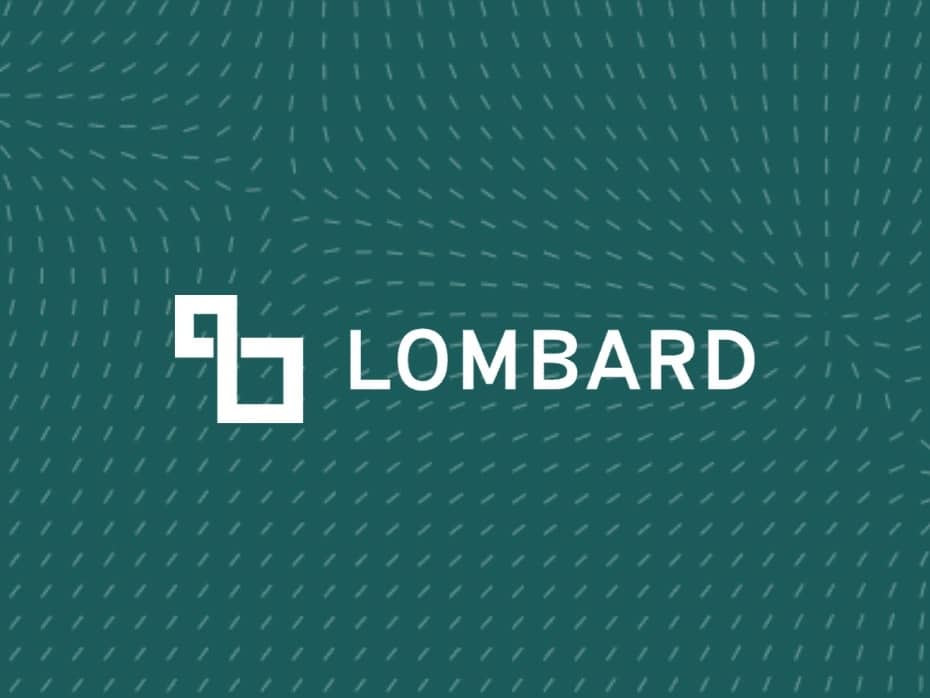위키 구독하기
Share wiki
Bookmark
Lombard Finance
Lombard Finance
Lombard Finance는 탈중앙화 금융(DeFi) 플랫폼으로, 비트코인의 유틸리티를 DeFi 생태계 내에서 확장하고자 합니다. 주요 토큰인 Lombard Staked BTC (LBTC)를 통해 스테이킹, 대출 및 기타 탈중앙화 금융 서비스를 제공합니다. [1]
개요
Lombard Finance는 탈중앙화 금융(DeFi)에 통합하여 비트코인(Bitcoin)의 유틸리티를 높이는 데 중점을 둡니다. 비트코인(Bitcoin)의 1조 5천억 달러 시가총액 중 상당 부분이 비활성 상태로 유지되는 점을 인식하여 Lombard는 이 자본의 일부를 DeFi 시스템 내에서 활성화하는 것을 목표로 합니다. 이 회사는 Babylon 기반의 유동적 스테이킹 토큰(LST)인 LBTC를 도입하여 비트코인(Bitcoin) 보유자가 기본 자산을 유지하면서 수익을 얻고 네트워크 보안에 기여할 수 있도록 합니다. 이러한 접근 방식은 비트코인(Bitcoin)의 경제적 가치를 스테이킹 및 DeFi 기회와 연결하여 디지털 경제에서의 역할을 강화하려는 것입니다. [5]
특징
롬바드 레저
롬바드 레저는 코스모스 앱 체인으로 권한 증명 방식으로 운영되며 모든 작업에 대한 투명한 온체인 기록을 제공하여 롬바드 프로토콜의 기반을 형성합니다. 보안 컨소시엄은 여러 당사자가 모든 거래에 서명하도록 보장하는 독립적인, 비트코인 중심 디지털 자산 기관 네트워크인 이 레저를 유지 관리하고 검증합니다. 이 분산 검증 방식은 단일 장애 지점을 제거하고 다자 승인 및 시간 잠금을 사용하여 프로토콜의 보안 및 무결성을 향상시킵니다.
보안 컨소시엄은 비트코인 예치금 확인, LBTC 주조 및 상환 승인, 바빌론 생태계를 통한 스테이킹 거래 촉진, 체인링크 CCIP와 같은 추가 안전 장치를 사용한 크로스체인 브리징 안전 관리를 담당합니다. 프로토콜 업그레이드 관리 외에도 컨소시엄은 BSN 보상의 수집 및 배포를 감독하는 동시에 모든 활동에 대한 검증 가능하고 불변의 기록을 제공하는 비잔틴 장애 허용 레저를 유지 관리합니다. [7] [8]
루미너리 프로그램
럭스 및 루미너리 프로그램(Lux and Luminary Program)은 LBTC 생태계에서 사용자 참여에 대한 보상을 위한 롬바드(Lombard)의 장기적인 계획입니다. 럭스(Lux)는 스테이킹된 BTC, LBTC 보유 또는 승인된 DeFi 통합에서 LBTC 사용을 통해 얻을 수 있습니다. LBTC 자체는 보유량과 기간에 따라 럭스를 축적합니다. 사용자는 롬바드 DeFi 볼트와 같이 배율이 높은 옵션에 LBTC를 예치하거나, "LBTC in DeFi" 페이지에 나열된 화이트리스트 DeFi 플랫폼에 참여하여 더 많은 럭스 보상을 받을 수도 있습니다. 효율성을 위해 단일 주소에 보상을 누적하는 것이 좋으며, 바빌론(Babylon)의 최종성 제공자에 대한 직접 스테이킹은 럭스에 해당되지 않습니다.
정기적인 누적 외에도, 럭스는 특별 루미너리 프로그램 이벤트를 통해 얻을 수 있습니다. 여기에는 플래시 기회, 추천 또는 콘텐츠 제작과 같은 커뮤니티 주도의 과제, 그리고 지속적인 참여에 대한 소급 보상이 포함됩니다. 럭스 잔액은 Sentio에서 추적하며, 지갑 및 DeFi 활동을 모니터링하여 보유량과 기간을 계산합니다. 사용자는 지갑을 연결하여 롬바드 앱에서 자신의 럭스를 확인할 수 있습니다. 이 프로그램은 투명하고 지속적인 인센티브를 제공하여 사용자 참여를 LBTC의 성장과 연계하는 데 도움이 됩니다. [4]
CubeSigner (큐브사이너)
CubeSigner는 Cubist가 개발한 비관리형 키 관리 플랫폼으로, 안전한 하드웨어를 통합하여 Lombard 인프라에서 사용되는 암호화 키를 보호합니다. HSM으로 봉인된 Nitro 인클레이브에 키를 저장함으로써, Cubist 또는 Lombard조차도 키에 접근할 수 없도록 하여 도난 및 무단 접근을 방지합니다. 서명 세션은 범위가 제한되고, 시간 제약이 있으며, 취소 가능하여 위반 및 내부 위협의 위험을 줄입니다. 또한 키별 정책은 대규모 거래에 대한 다자 승인 요구 등 키 사용을 제어합니다. CubeSigner는 Babylon 관련 보호 기능도 포함하고 있는데, 예를 들어 검증자가 운영상의 오류로 인해 유해한 메시지에 서명하는 것을 방지하는 안티 슬래싱(anti-slashing) 조치가 있습니다.
Lombard 아키텍처 내에서 CubeSigner는 사용자 지정 하드웨어 강화 정책(Cubist는 이를 오프체인 하드웨어 내장형 스마트 계약이라고 부릅니다)에 연결된 Bitcoin 키를 생성하고 관리합니다. 이러한 정책은 접근 제어, 거래 유형, 사용 제한, 다자 인증 및 시간 기반 제한을 정의합니다. 예를 들어, 사용자 키는 특정 Babylon 거래 유형으로 제한되며 입금 및 출금에는 신뢰할 수 있는 거래 상대방이 필요합니다. 다자 인증은 중요한 작업에 여러 서명자와 인증 요소가 필요하도록 보장하며, 타임락은 승인된 작업에도 지연을 적용하여 보안 계층을 추가합니다. 이 아키텍처를 통해 Lombard는 운영 유연성과 분산화를 유지하면서 키를 안전하게 관리할 수 있습니다. [9]
바스큘 드로브리지(Bascule Drawbridge)

바스큘 드로브리지(Bascule Drawbridge)는 롬바드(Lombard) 아키텍처의 추가적인 보안 계층으로, 큐비스트(Cubist)가 독립적으로 운영하여 보안 컨소시엄(Security Consortium)이 수행한 작업을 검증합니다. 이는 상태 오라클 (oracle) (오라클)로서 기능하며, 해당 스마트 계약 (smart contract) (스마트 계약)을 통해 지원되는 목적 체인에서 비트코인 (Bitcoin) (비트코인) 네트워크 데이터의 정확성을 검증합니다. 이 메커니즘을 통해 바스큘(Bascule)은 2차 권한으로 작용하여 모든 비트코인 (Bitcoin) (비트코인) 예치가 6블록 확인 후에 인정되도록 합니다. LBTC를 발행하려면 보안 컨소시엄(Security Consortium)의 유효한 서명과 바스큘 드로브리지(Bascule Drawbridge)의 일치하는 증명이 필요하며, 이는 크로스체인 브리지 악용에 대한 저항력을 강화하는 이중 검증 프로세스를 만듭니다.
역 바스큘 드로브리지(Reverse Bascule Drawbridge)는 오프체인에서 작동하며 LBTC 상환을 처리합니다. 사용자가 상환 기능을 시작하면 LBTC가 온체인에서 소각 (burned) (소각)되고, 큐비스트(Cubist)가 이러한 이벤트를 모니터링합니다. 확인 기간 후, 상환 상태가 큐브사이너(CubeSigner)에 기록됩니다. 큐브사이너(CubeSigner)는 상환이 발생했는지 확인한 후에 컨소시엄(Consortium)이 시작한 비트코인 (Bitcoin) (비트코인) 인출을 진행합니다. 이러한 온체인 및 오프체인의 양방향 확인은 비트코인 (Bitcoin) (비트코인)과 LBTC 생태계 간의 정확성과 일치성을 보장하여 허위 또는 무단 거래의 위험을 최소화합니다. [10]
PMM 모듈
PMM(Private Market Maker) 모듈은 Lombard Protocol이 특정 블록체인에 배포한 스마트 계약으로, BTC(비트코인) 파생 자산(예: BTCB)을 보유한 사용자의 온보딩 경험을 개선하기 위해 고안되었습니다. 이 모듈을 통해 사전 정의된 위험 한도 내에서 이러한 자산을 LBTC로 교환할 수 있으며, 대부분의 LBTC가 기본 비트코인으로 뒷받침되도록 합니다. 이 모듈은 교환되는 자산에 따라 수수료를 적용하며, 재정적 차익거래를 위한 것이 아니라 사용자 편의 기능으로만 의도되었습니다. 오용이 감지될 경우 추가적인 보안 제한이 적용될 수 있습니다.
BNB Smart Chain과 같은 체인에서 PMM은 BTCB를 LBTC로 전환하는 기능을 제공하며, 민팅 가능한 LBTC의 양을 추적하고 운영 비용을 충당하기 위한 수수료를 적용합니다. 이러한 스마트 계약은 비트코인 기반이 아닌 자산에 대한 일시적이고 제한적인 노출을 보장하여 LBTC의 안정성을 유지합니다. 이러한 방식으로 획득된 모든 BTC는 자산의 기본 비트코인 담보를 유지하기 위해 Babylon에 스테이킹됩니다. [11]
LBTC
LBTC는 비트코인(Bitcoin)과 1:1로 연동되는 유동적인 수익 생성 비트코인(Bitcoin) 토큰으로, 크로스체인 사용을 위해 설계되었습니다. 비트코인(Bitcoin)을 DeFi(탈중앙화 금융) 생태계에 통합하는 동시에 자산의 원래 보안을 유지합니다. LBTC는 블록체인(Blockchain) 네트워크 간의 이동을 지원하며 유동성(Liquidity)을 분할하지 않고, 대출, 차용, 거래와 같은 다양한 DeFi(탈중앙화 금융) 애플리케이션에서 담보로 사용될 수 있습니다.
LBTC는 바빌론 스테이킹 및 기타 메커니즘을 통해 기본 수익을 얻으며, 지원되는 프로토콜 및 생태계에 참여하여 추가 보상을 받습니다. 보안 모델은 컨소시엄 구조에 의존하여 중앙화되거나 검증되지 않은 래핑 토큰에 대한 더욱 강력한 대안을 제공합니다. 보유자는 LBTC를 사용하여 DeFi(탈중앙화 금융) 활동에 참여함으로써 수익률을 높일 수 있습니다. [6]
DeFi 볼트
롬바드 DeFi 볼트는 LBTC, wBTC, eBTC, cbBTC와 같은 비트코인 기반 자산을 DeFi 프로토콜에 배분하여 수익을 최적화하는 자동 수익 관리 시스템입니다. 베다(Veda)와의 파트너십으로 개발된 이 볼트는 전략 선택, 실행 및 보상 복리화를 자동화하여 DeFi 참여의 복잡성을 줄입니다.
사용자는 지원되는 비트코인 파생상품을 볼트에 예치하고, 원금, 수익 및 추가 포인트 기반 보상을 포함한 볼트 총 잔액의 지분을 나타내는 토큰인 LBTCv를 받습니다. 볼트는 Uniswap 및 Curve 유동성 제공, Gearbox 및 Morpho 대출, 그리고 Pendle을 통한 수익 거래와 같은 전략에 자본을 배분합니다. 성과는 적극적으로 관리되고 재조정됩니다.
수익은 자동으로 재투자되며, 보상은 LBTCv 보유자에게 비례적으로 배분됩니다. 인출은 대기열을 통해 처리되며 일반적으로 3일 이내에 완료되지만, 토큰 유형에 따라 소액의 수수료가 부과될 수 있습니다. 추가 포인트 인센티브가 제공되며, 현재 Ethereum 및 Base 네트워크에서 예치가 지원됩니다. [12]
자금 조달
2024년 7월, Lombard Finance는 Polychain Capital이 주도하는 시드 라운드에서 1600만 달러를 조달하여 Babylon과 파트너십을 맺고 Bitcoin 리스테이킹 생태계 개발을 지원했습니다. 참여자로는 BabylonChain, dao5, Franklin Templeton, Foresight Ventures, HTX Ventures (후오비), Mirana Ventures, Mantle EcoFund, Nomad Capital, OKX Ventures, 및 Robot Ventures가 있으며, Bitget, Bybit, OKX, 및 HTX와 같은 거래소의 LBTC 유동성 및 더 넓은 DeFi 통합에 대한 추가 지원도 받았습니다.
Lombard의 작업은 Babylon의 프로토콜을 사용하여 Bitcoin이 Proof-of-Stake (PoS) 시스템에서 담보 역할을 할 수 있도록 하는 데 중점을 두고 있습니다. 이 프로토콜을 통해 BTC를 네이티브하고 자체 보관 방식으로 스테이킹하여 PoS 네트워크를 보호할 수 있습니다. 팀에는 Argent, Coinbase, 및 Maple과 같은 회사 출신의 경험 많은 인력이 포함되어 있습니다. David Tse와 Dr. Fisher Yu가 2022년에 설립한 Babylon은 Bitcoin의 유틸리티를 PoS 생태계로 확장하면서 보안 속성을 유지하는 인프라를 개발합니다. [2][3]
파트너십
- EigenLayer (아이겐레이어)
- Babylon (바빌론)
- Polychain Capital (폴리체인 캐피탈)
- Franklin Templeton (프랭클린 템플턴)
- OKX (OKX)
- ByBit (바이비트)
- ether.fi (이더.fi)
- Maple (메이플)
- Chainlink (체인링크)
- Sui (수이)
- Pendle (펜들)
- Veda (베다)
- Immunefi (이뮤니파이)
- Halborn (할본)
잘못된 내용이 있나요?
